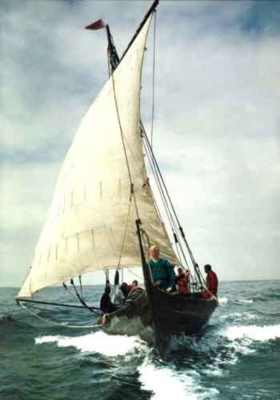The Vikings and their Ships

Of all the images that the word “Viking” conjures up, that of the Longship is one of the most memorable – and one of the few that the general public gets right. We know now that most Vikings didn’t have long, unkempt hair; that they would fight with other weapons than battleaxes; and that the horned helmet is not much more than a myth. But the image of the Longship endures, and rightly so. It is what defined the Vikings, and the Viking Age. Its impact, and its legacy, was as complex as the people themselves.
It was in their ships that fierce, hard-hearted raiders wrought devastation and chaos on the coasts of Northern Europe for centuries. It was in their ships that the Vikings opened up new trade routes from east to west, north to south, founding towns as far apart as Ireland and Ukraine. Kings and chieftains were buried with lavish ceremony in their ships to demonstrate the wealth and power of their dynasty. Those who would not live under such rule fled in their ships to found new colonies in Britain, Ireland, Iceland, Normandy. Armies would embark on their ships for wars of conquest. Explorers would return with stories of the ancient civilisations of the East, or strange new lands to the west. To this day, scholars argue as to what the word “Viking” means. Yet there would have been no Viking Age without Viking ships.
Not all ships of the Viking Age were the same, of course. Some were little more than dinghies, allowing people and livestock to sail from one island to the next. Others were built to follow the wind, unsure of where the next landfall would be. At the new ports being built on the back of trade and plunder, big beamed cargo ships would offload their wares, whilst long, sleek, dragon-prowed warships would turn at anchor, reminding all of the authority of the emerging kingdoms. Royal yachts could be buried with their owner in pagan splendour. Clapped out fishing boats might end their days as scrap, revetments for a harbour wall or sunk to block a passage to a fjord. Yet they, like their owners, shared a common heritage.
Regia Anglorum possesses the largest fleet of replica Viking ships on this side of the North Sea. Owning them, repairing them and sailing them gives us an insight into what life must have been like for the Viking sailors. For more about the Regia fleet of replicas and the experiences sailing them, please visit the Fleet section of this website.
Types of Ship
All Viking ships have several things in common; they are all clinker built, and all reasonably symmetrical front to back. This is true for the 6m (20′) long four-oared rowing boat found with the 9th century Gokstadt burial and the 36m (120′) long 33-oared warship dated to the middle of the 11th century. However, within these parameters there was a considerable variation.
The longships grab all of the glory. The most famous one is perhaps the most atypical. The grave of a great chieftain was excavated with great care in the 19th century, revealing a beautiful ship – now called the Gokstad Ship. This boat was 23m (76′) long and 4.8m (16′) broad. This is now thought to be a “general purpose” type; a ship excavated at Ladby in Denmark in the 1930s may be a more typical warship – it was about the same length, but only 2.9m (9′) wide. Being narrower, it was faster, but could carry less cargo – but then, this was a pure warship.
As the Viking Age progressed, the Warships got longer – and smaller! The larger ships would have been owned by the nobility – Kings or Earls – and they were statements of wealth and power. By the eleventh century the largest ships were often over a hundred feet long, with crews of up to one hundred men – all of them trained warriors, parts of the ship-owner’s retinue. However, there were smaller levy ships – one that has been found is less than 18m (60′) long. This was probably a levy ship – a vessel maintained by a group of villages for the purpose of defending their own coast. The Vikings were now attacking themselves.
The trading vessels were perhaps the hidden revolution in the Viking Age. They took the basic plan of the Viking ship, and instead of just stretching it forward, they stretched it sideways as well. They carried a large sail, and a small crew – maybe only six to ten people – and only had a few oarports at the front and back. No-one rowed in the middle of the boat – that was where the cargo went. One of the largest Viking cargo ships was found in Hedeby harbour – the great trading post of Viking Denmark. It was 22m (73′) long but 6.2m (21′) broad, and could probably carry around 60 tons of cargo – and yet at full load it only needed 1.5m (5′) of water to float in.
Most Viking trading boats were able to come ashore without the need of complicated harbour facilities, and yet carry many tons of cargo. This encouraged international trade and economic growth. Eventually towns sprang up to service this trade – the first towns in Scandinavia were based around such trading centres, all of Ireland’s first cities were Hiberno-Norse trading outposts, and the re-building of London in the 10th century (away from the Aldwych, the “old trading post”) was based around the reconstruction of the Roman wharves. Eventually, the trade became so lucrative that it became worthwhile investing in larger, more cumbersome boats and complex port facilities. This meant that the Viking trading ship began to lose out to the heavier, slower Cog in the twelfth and thirteenth centuries.